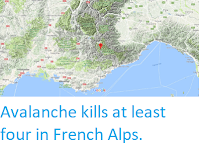Three skiers have been confirmed dead following an avalanche near the resort of Lech am Arlberg in the Austrian state of Vorarlberg on Saturday 12 January 2019. The men, identified as German nationals, were located by a mobile phone signal after authorities were alerted by one of their wives. A fourth member of the party is still missing. The men were found close to the Langer Zug ski slope, one of the world's steepest pistes (prepared ski runs), which had been closed off due to poor conditions in the area, and were apparently equipped with touring skis, used for ascending slopes and off piste skiing (skiing away from organised trails).
The approximate location of the 12 January 2019 Lech am Arlberg avalanche. Google Maps.
Avalanches are caused by the mechanical failure of snowpacks;
essentially when the weight of the snow above a certain point exceeds
the carrying capacity of the snow at that point to support its weight.
This can happen for two reasons, because more snow falls upslope,
causing the weight to rise, or because snow begins to melt downslope,
causing the carrying capacity to fall. Avalanches may also be triggered
by other events, such as Earthquakes or rockfalls. Contrary to what is
often seen in films and on television, avalanches are not usually
triggered by loud noises. Because snow forms layers, with each layer
typically occurring due to a different snowfall, and having different
physical properties, multiple avalanches can occur at the same spot,
with the failure of a weaker layer losing to the loss of the snow above
it, but other layers below left in place - to potentially fail later.
Diagrammatic representation of an avalanche, showing how layering of snow contributes to these events. Expedition Earth.
This incident is the latest in a string of snow related fatalities across the Alps and Northern Europe this week. This is due to warm conditions over the North Sea, which has led to more evaporation, and humid air moving over Europe from the north. As this has met cold air from the Alps it has fallen as snow. Large amounts of snow falling onto mountain slopes over a short period of time is more dangerous than similar amounts of snow over a longer period, as it leads to poorly consolidated snow beds, which lack much internal strength, and therefore are easier to dislodge as avalanches.
See also...
Follow Sciency Thoughts on Facebook.








